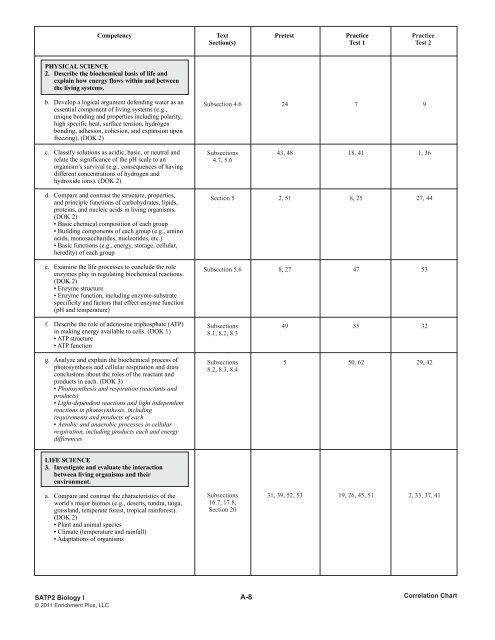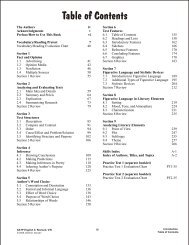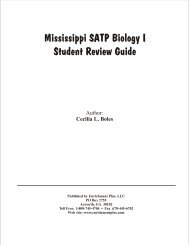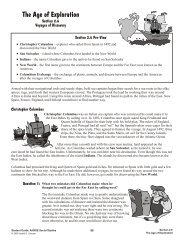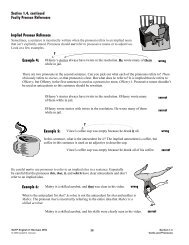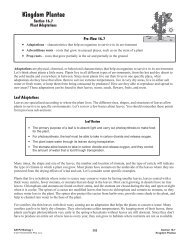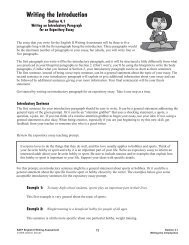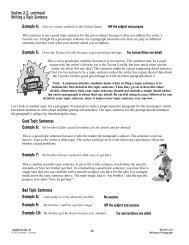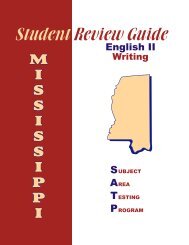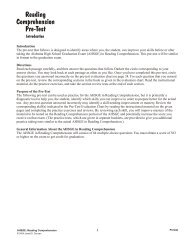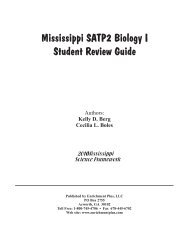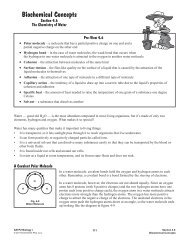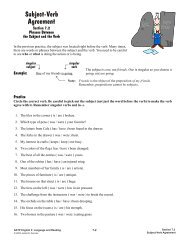Mississippi SATP2 Biology I Student Review Guide - Enrichment Plus
Mississippi SATP2 Biology I Student Review Guide - Enrichment Plus
Mississippi SATP2 Biology I Student Review Guide - Enrichment Plus
Create successful ePaper yourself
Turn your PDF publications into a flip-book with our unique Google optimized e-Paper software.
Competency<br />
Text<br />
Section(s)<br />
Pretest<br />
Practice<br />
Test 1<br />
Practice<br />
Test 2<br />
PHYSICAL SCIENCE<br />
2. Describe the biochemical basis of life and<br />
explain how energy flows within and between<br />
the living systems.<br />
b. Develop a logical argument defending water as an<br />
essential component of living systems (e.g.,<br />
unique bonding and properties including polarity,<br />
high specific heat, surface tension, hydrogen<br />
bonding, adhesion, cohesion, and expansion upon<br />
freezing). (DOK 2)<br />
Subsection 4.6 24 7 9<br />
c. Classify solutions as acidic, basic, or neutral and<br />
relate the significance of the pH scale to an<br />
organism’s survival (e.g., consequences of having<br />
different concentrations of hydrogen and<br />
hydroxide ions). (DOK 2)<br />
Subsections<br />
4.7, 5.6<br />
43, 48 18, 41 1, 36<br />
d. Compare and contrast the structure, properties,<br />
and principle functions of carbohydrates, lipids,<br />
proteins, and nucleic acids in living organisms.<br />
(DOK 2)<br />
• Basic chemical composition of each group<br />
• Building components of each group (e.g., amino<br />
acids, monosaccharides, nucleotides, etc.)<br />
• Basic functions (e.g., energy, storage, cellular,<br />
heredity) of each group<br />
e. Examine the life processes to conclude the role<br />
enzymes play in regulating biochemical reactions.<br />
(DOK 2)<br />
• Enzyme structure<br />
• Enzyme function, including enzyme-substrate<br />
specificity and factors that effect enzyme function<br />
(pH and temperature)<br />
Section 5 2, 51 8, 25 27, 44<br />
Subsection 5.6 8, 27 47 53<br />
f. Describe the role of adenosine triphosphate (ATP)<br />
in making energy available to cells. (DOK 1)<br />
• ATP structure<br />
• ATP function<br />
g. Analyze and explain the biochemical process of<br />
photosynthesis and cellular respiration and draw<br />
conclusions about the roles of the reactant and<br />
products in each. (DOK 3)<br />
• Photosynthesis and respiration (reactants and<br />
products)<br />
• Light-dependent reactions and light independent<br />
reactions in photosynthesis, including<br />
requirements and products of each<br />
• Aerobic and anaerobic processes in cellular<br />
respiration, including products each and energy<br />
differences<br />
Subsections<br />
8.1, 8.2, 8.3<br />
Subsections<br />
8.2, 8.3, 8.4<br />
49 55 32<br />
5 50, 62 29, 42<br />
LIFE SCIENCE<br />
3. Investigate and evaluate the interaction<br />
between living organisms and their<br />
environment.<br />
a. Compare and contrast the characteristics of the<br />
world’s major biomes (e.g., deserts, tundra, taiga,<br />
grassland, temperate forest, tropical rainforest).<br />
(DOK 2)<br />
• Plant and animal species<br />
• Climate (temperature and rainfall)<br />
• Adaptations of organisms<br />
Subsections<br />
16.7, 17.8,<br />
Section 20<br />
31, 39, 52, 53 19, 26, 45, 51 2, 33, 37, 41<br />
<strong>SATP2</strong> <strong>Biology</strong> I<br />
© 2011 <strong>Enrichment</strong> <strong>Plus</strong>, LLC<br />
A-8 Correlation Chart


